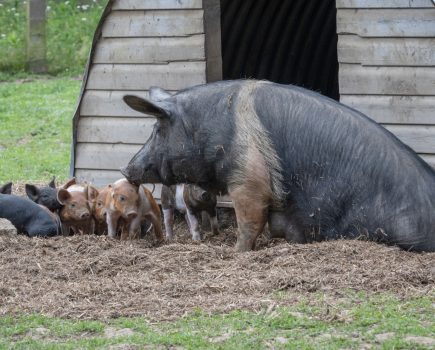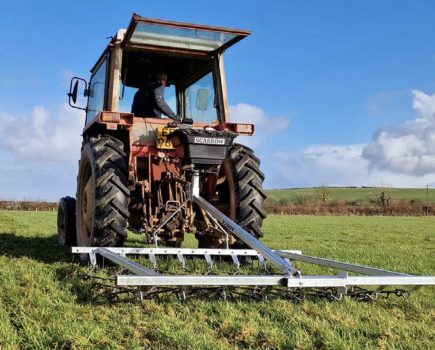Debbie Kingsley visits Farms for City Children, the charity set up by writer Michael Morpurgo and his wife Clare.
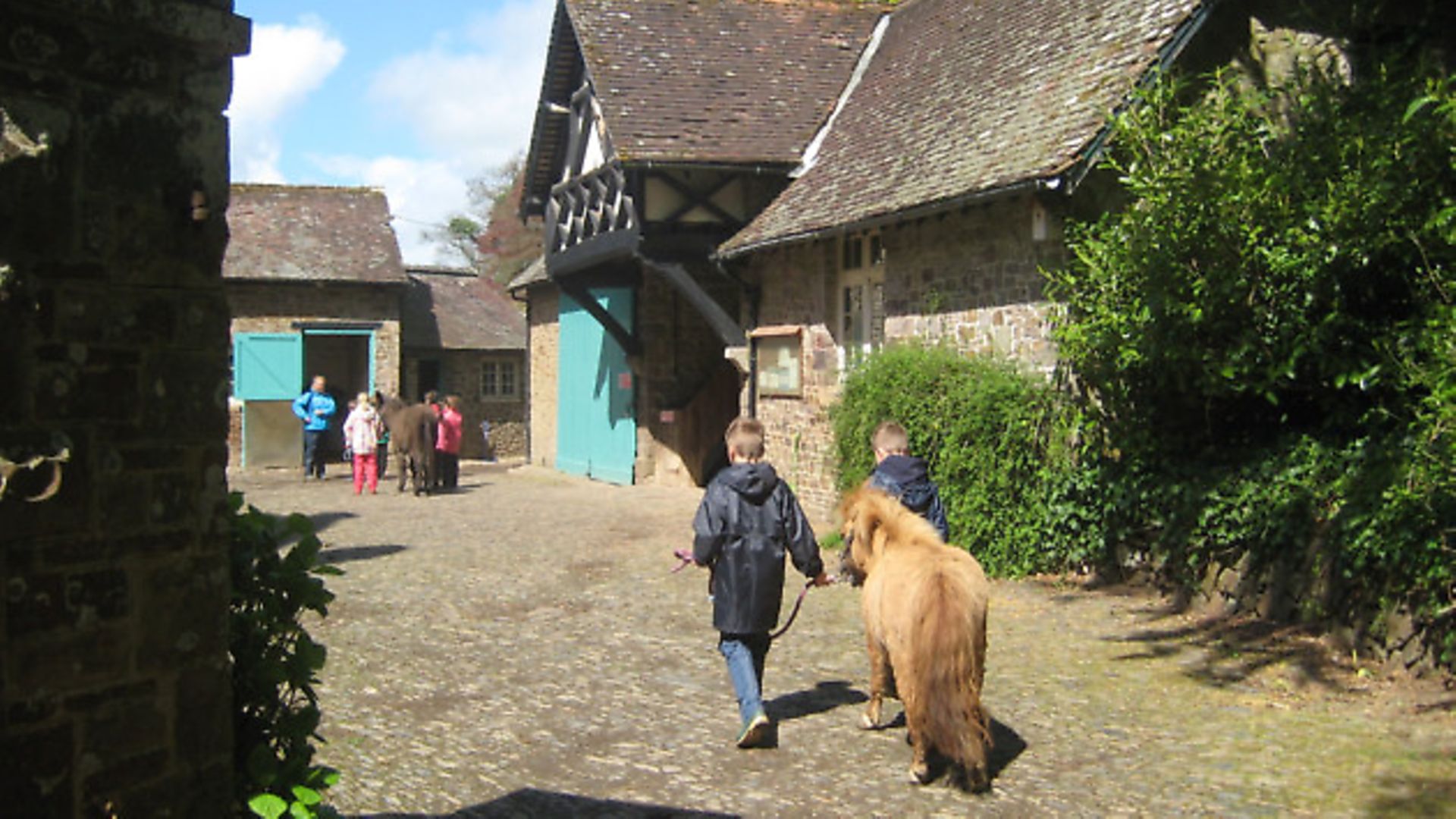
I have been to a child’s paradise. Seven miles from our farm, across Hatherleigh Moor and down the deep Devon lanes towards Iddesleigh, sits Nethercott House, a Victorian manor with 50 acres and breathtaking views that exudes calm, charm, barely contained excitement and efficiency. Forty years ago Clare and Michael Morpurgo founded the charity Farms for City Children and bought the property to offer urban children from all over the country a unique opportunity to live and work together for a week at a time on a real farm in the heart of the countryside. As School Manager Catherine Knight puts it “It is an intense, ‘learning through doing’ experience of a different life – for children who may not know where their food comes from and have limited opportunities to explore the outside world”.
The experience is hugely enhanced through the charity working in close partnership with farmer brothers David and Graham Ward who own the two neighbouring farms (Parsonage Farm and Bridgetown Farm), giving visiting children access to over 500 acres, and to their organic dairy herd and sheep and beef farm. Their father John Ward had been involved in Farms for City Children at its founding in 1976 and they have continued the partnership to this day.
On the day I visited it was day two of Plymouth’s Leigham Primary School’s week. The school has been bringing children to Nethercott for fourteen years and the teachers I spoke too were as enthusiastic as their pupils, and very aware of the benefits. At 7.30am, before breakfast, the children had fed the poultry (chickens, geese, turkeys and guinea fowl) and collected the eggs, watched the cows being milked and fed the beef herd and sheep flock. After breakfasting on Nethercott eggs the children cleared up and I watched three children sweep the dining room floor with huge brooms and great cheer. Then it was on with the wellies and waterproofs and out to feed the pigs, some Landrace/Pietrain/Duroc crosses and pure Large Blacks. The feed was carefully weighed by the children, all under close supervision of Farm Manager Lee Blake. First approaches to the Large Black gilts were a bit tentative but within moments the children (all around 9 years old in this group) were rubbing their backs and visibly growing in confidence around such big animals.
The children are split into three groups of up to 13 pupils each, looked after by their teachers and a member of staff. Stuart Coles, the Deputy Farm Manager, had taken another group to bring in the donkeys and ponies grazing close to the house. A train of widely smiling boys and girls, clearly managing to contain their glee, just about, led them to their stables. There was no shouting or running – they knew just how to behave around the animals even though they had been on site for less than 24 hours – they were calm, but their delight was obvious.
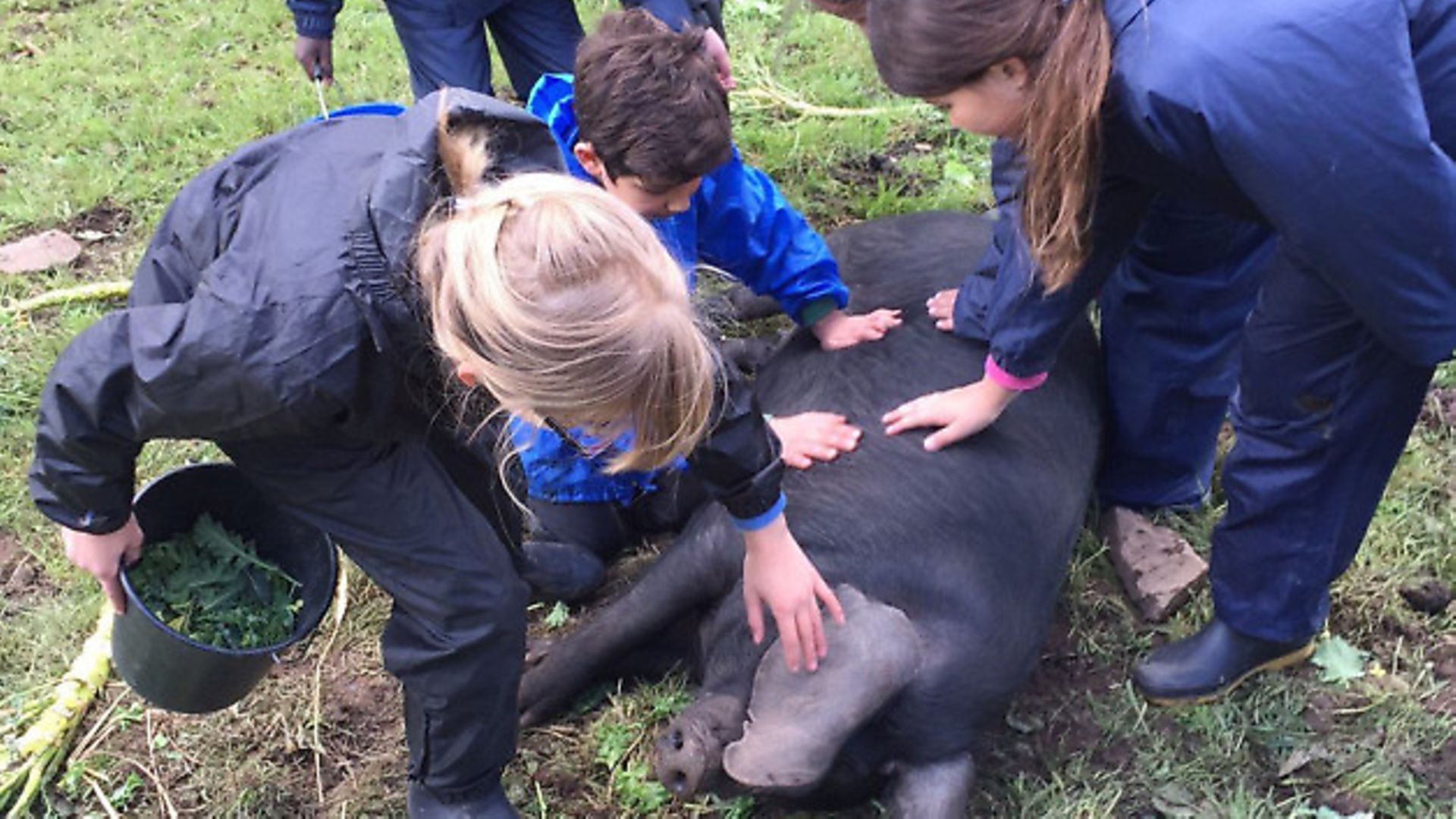
Although there are plenty of activities based on the livestock, the children experience the outdoors in many other ways too. In the spinney, a lovely copse carpeted in wild garlic when I visited, is a beautiful cob roundhouse, built by groups of visiting children and used during the Forest School sessions. Here the children stand around a camp fire to make charcoal, weave willow, produce ropes from rush and engage in some basic woodworking. They build dens and let off steam, playing in the sun-dappled enclosed woodland; it really is idyllic. They also work with some of Devon’s many wonderful artists, perhaps basket weaving with Linda Lemieux, or felting wool with Yuli Somme, making their own felt slippers that capture every detail of the children’s toes. Gardening is also increasingly a focus for activities, with the children learning about growing their own food and preparing it for meals. In the autumn there is apple pressing and there are competitions to see which school can press the most juice in an hour. There are hopeful plans to convert a stable into a food preparation area where the children can grind wheat, make bread and cheese and engage even more deeply in food production.
The poultry field hosts Buff Orpington, Light Sussex, Golden Brahma and Welsummer chickens, Red Bourbon and Wild Kentucky turkeys and guinea fowl. Not surprisingly, the house is entirely self sufficient in eggs and they use the broody Brahmas as well as incubators to rear birds. The geese have a rather splendid cob goose hut of their own.
The farm dairy has been adapted so that the children can view milking safely from above, the platform ensuring a fantastic bird’s eye view of what’s going on. They learn about the ages of the cows, how the cluster on the milking machine is attached to the cow and lots more. The farm environment creates endless opportunities for learning and discussion; animal husbandry, the products that result from the milk from the dairy herd, the financial elements of running a farm business, the life cycle of each animal, the process of reproduction and also the methods of slaughter of animals for meat.
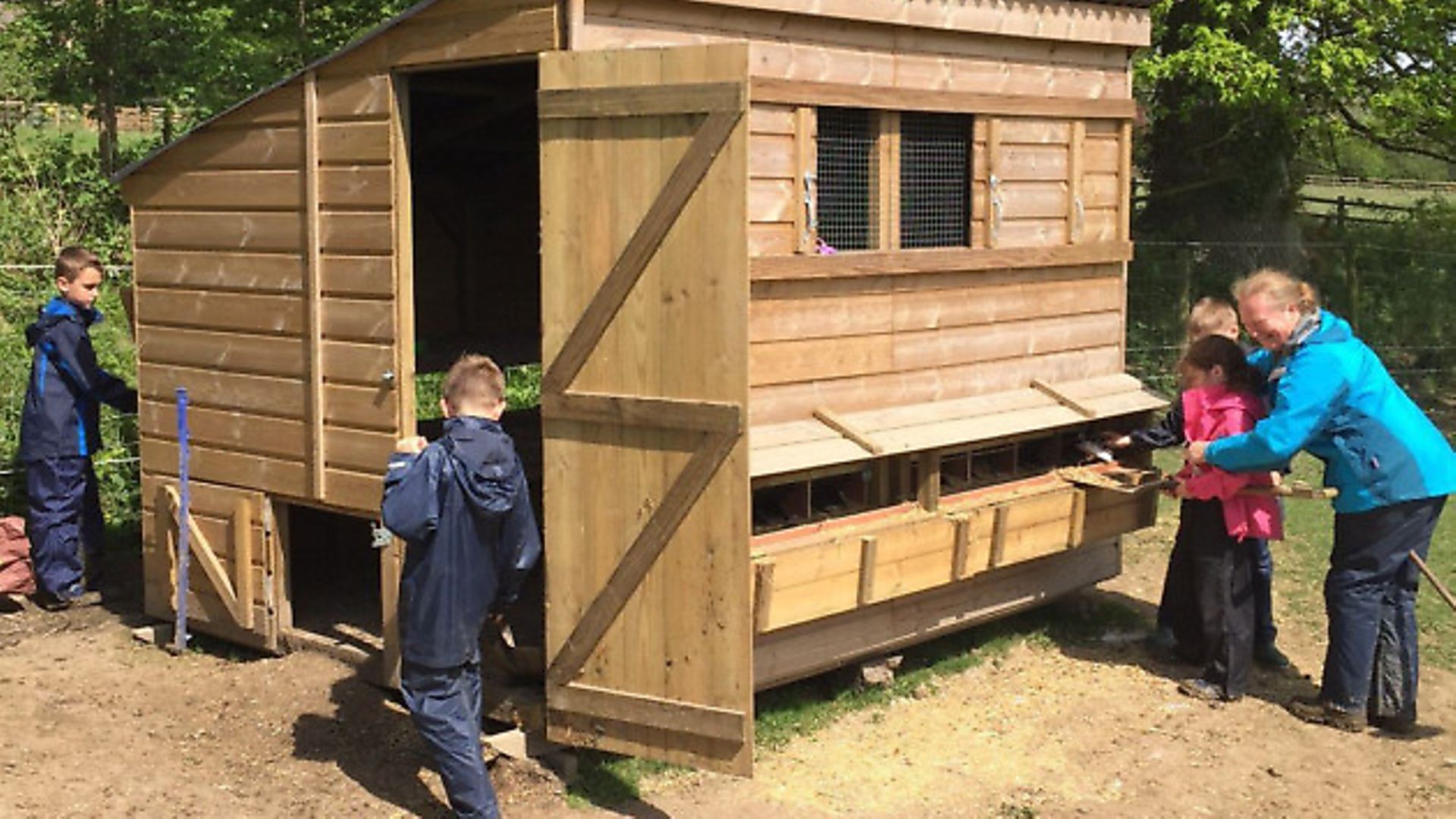
Catherine, who knows all the children’s names already (as do all the staff, which is incredible considering there was another group of over thirty children on site just the day before), is very conscious about the responsibilities involved in running such a complicated organisation. Health and safety considerations for the children are paramount and there are activities such as being down on the milking parlour floor and mucking out deep litter, that can no longer be undertaken as insurance just won’t cover them. There is a detailed and meticulous hygiene regime in place that everyone has to abide by. Summer and winter, waterproof trousers, jackets and wellies must be worn and hosed off and disinfected every time they are used. Hand washing facilities are everywhere and staff keep a watchful eye to make sure small hands that have been patting livestock aren’t put into their owner’s mouth. Another rule is the complete ban on computers, television and any electronic device – the children have full, fascinating days that don’t require any access to such distractions. Come 8.30pm or so it’s bedtime and the children are treated to a bedtime story, normally one of Michael Morpurgo’s tales. The War Horse writer’s house is just beyond Nethercott and the children make all kinds of connections between what they see during the day and the characters and descriptions in the books.
The house is open to schools for at least thirty weeks a year, and following Nethercott’s success, 25 years ago a second centre was set up in Wales and in 1986 a third property in Gloucestershire. Together, the three Farms for City Children properties welcome a total of 90 or so groups, that’s 3000 children every year. The demand for these wonderful life-enhancing experiences cannot be met, so there is every chance that the organisation will grow if a suitable propertiy with the right farming partner can be found. Schools are expected to find 70% of the cost (around £250 per child for the week, including the transport costs) and the remaining costs are subsidised by the charity. Many schools book a year in advance which enables parents to pay a small amount each week to cover their contribution, and because of the invaluable nature of the experience schools often tap into their pupil premium monies to support the visits.
Catherine says that the children are in awe of the animals, and that the responses the children have to this environment cannot be replicated inside a traditional classroom. I have to agree, as would most smallholders – the reason we all do what we do is to feel that same sense of excitement and achievement every single day. Catherine believes the children’s experience will have a long term positive impact on their lives – how they eat, how they think about food and how they consider animals and livestock. Certainly their knowledge increases significantly as does their understanding of the rural life. There may be many budding smallholders being nurtured at Nethercott and its sister farms.
Getting children involved with smallholding
I can’t imagine anything easier than getting children hands-on with the amazing variety of tasks around the smallholding. Nearly everything we do on our holdings can be seen as a pleasurable activity, from collecting warm eggs from the hen hut each morning to checking if the carrots are sprouting through the soil and making sure all sheep are present and correct with no limps or heads stuck through fences. Children and adults alike love ducklings, chicks, lambs and piglets, being around them, feeding and watering, keeping their accommodation clean. There is just so much choice in smallholding, whether it be incubating hatching eggs, growing vegetables, pressing apples, making a simple cheese, picking blackberries or just walking with eyes open in nature sometimes on your own and at other times with a knowledgeable friend. Sharing these things with children is simple. I remember a friend’s young daughters asking if they could help pluck and dress a chicken – nothing fazed them and they were delighted that the chicken was to be eaten as part of a delicious supper
Any age benefits from smallholding
Farms for City Children welcome children from 9 to 12 years, but smallholding has a place for people of any age. Obviously there are dangers on any holding that need to be managed and minimised for those less able to watch out for themselves, but I’d hate to compile a list of potential risks that puts people off involving children in such a rich and varied way of life. You’re never too young or too old to cram a freshly plucked strawberry in your mouth or hang over a gate to smile at a pair of lambs suckling so vigorously that they lift a ewe off her feet. There are city farms all over the country, so the most urban dweller is able to take their children to an invigorating environment to learn about livestock and the production of food.
I am sure that one of my earliest memories of being taken by my father to the bit of green belt near our Greater London semi to moo at the cows, had a role in shaping my destiny. If moments like that are life-enhancing, just imagine what a week at Farms for City Children or regular visits to your local city farm can do for the youngest of children.
Contacts:
Federation of city farms and community gardens
Image(s) provided by:
Archant
Archant
Archant




